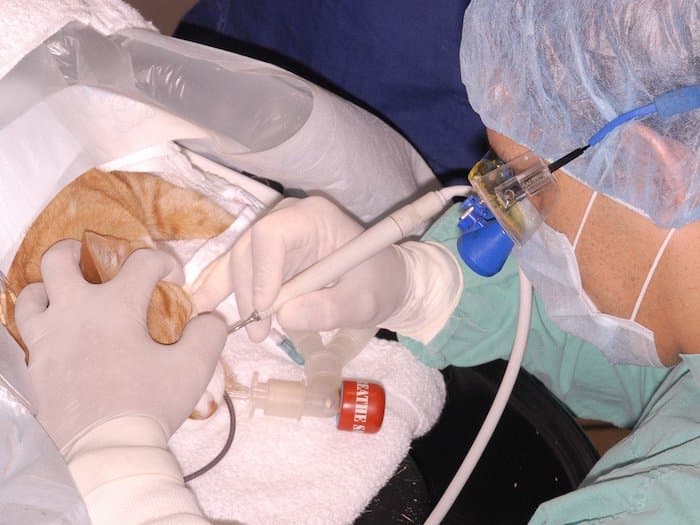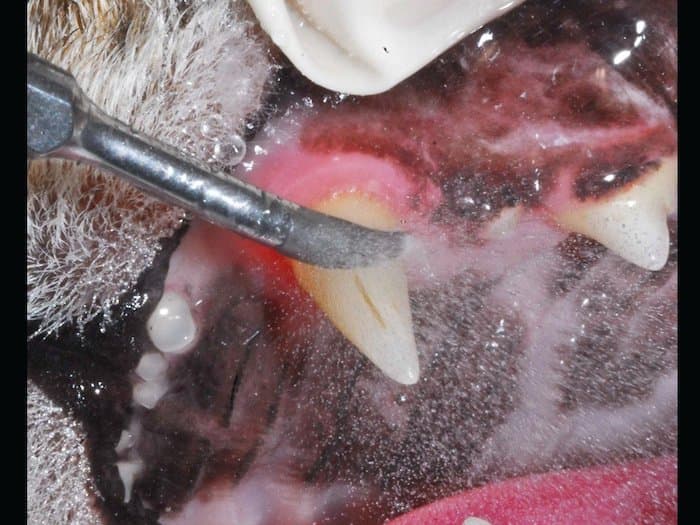Cats do not tend to suffer from tooth decay the way we do, but they are prone to other kinds of dental disease. Eventually, this disease often requires dental treatment under anesthetic. To stop dental disease building up, you can take various preventive measures including brushing your cat's teeth at home.
What is dental disease and how does it develop?
Cats are prone to three kinds of dental disease: gingivitis, periodontitis and tooth resorption. Of these, the first two are related, as untreated gingivitis (inflammation of the gums) leads to periodontitis (inflammation of the tissues that attach the teeth to the gums and bone).
Gingivitis and periodontitis start with a build-up of plaque, which is a thin layer of bacteria and other material that coats the teeth. Over time, this plaque thickens and becomes mineralized, forming tartar which you might see on your cat's teeth as hard yellowish material. Where the plaque and tartar meet the gums, the bacteria make the gums sore, red and inflamed. The attachment of the gums to the teeth is disrupted, and plaque and tartar can build up in deep pockets next to the teeth, as shown in the following animation. Eventually, the tooth can become loose.
Animation on periodontal disease progression in the cat:
The third type of dental disease that cats often develop is tooth resorption . In this condition, the structure of the tooth itself is broken down for an unknown reason. The signs of tooth resorption are less obvious than tartar, but your vet may be able to see little 'resorptive lesions' where the tooth is eroded, often at the base by the gum. These lesions can be painful and they sometimes come alongside gingivitis (inflammation of the gums).
Dental disease is very common in pet cats - it is estimated that most cats over the age of four are affected.
What are the signs of dental disease?
Dental disease is easy to overlook as it is so common. However, it can be very sore for your pet, so it is worth keeping a lookout for it. Here are the signs of dental disease to watch out for:
- Visible tartar on the teeth
- Inflamed gums
- Smelly breath
- Signs of pain in the mouth and rubbing the mouth, becoming fussy with food or losing interest in toys
- Eating on one side of the mouth
- Dribbling, possibly with blood in saliva
If your cat is showing signs of dental disease, take them to your vet for a check-up. Your vet will be able to advise whether any dental treatment is necessary. If you catch the dental disease early, it is more likely that you will be able to manage it with home care and avoid a dental procedure.
How is dental disease treated?
If your cat has mild dental disease, your vet may advise you to manage this at home with toothbrushing and potentially oral hygiene products (more on this below!). However, if the dental disease is more advanced, your cat may need to go into the vet for some dental treatment under anesthetic. In this process, your vet will assess how severe the disease is and check whether any teeth need to be removed.
When your vet is assessing whether teeth should be extracted, they will check the size of the pocket between the gum and the tooth using a special probe as shown in the following animation. If there is a large pocket, it may not be possible to save the tooth.
Animation on dental probing:
Your vet may also perform X-rays to assess the teeth. These will be especially helpful if your cat has tooth resorption, as X-rays can show whether the tooth root is losing its normal structure. After extracting any teeth that should be removed, your vet will then remove the tartar using an ultrasound scaler.
Animation on scaling:
Images of professional tooth cleaning in the cat:


How can dental disease be prevented?
The most effective way to prevent dental disease is by brushing your cat’s teeth. Ideally, it is best if you do this every day, using a special cat toothpaste. It can take a little while to get your cat used to toothbrushing, but if you choose a tasty toothpaste and make it a pleasant experience for them with lots of fuss afterwards, it should usually be possible to integrate this into your normal routine.
Video of toothbrushing in the cat:
There are various kinds of cat toothbrushes available, including ‘finger toothbrushes’ that you can slip onto your finger. Choose a type that suits you and your cat, with advice from your vet if necessary.
If you have a young cat, it is worth getting them used to toothbrushing early on. You can start out just by putting your finger around their gums to get them used to the process.
If your cat dislikes the toothbrush, or if you are just getting them used to the idea of toothbrushing, you can use Q-tips or dental wipes as shown in the videos below.
Video of tooth cleaning using Q tips or cotton buds:
Video of tooth cleaning using wipes:
Your vet will be able to advise on a good cat toothpaste. Bear in mind that human toothpaste is not good for cats.
You can also discuss the right diet for your pet with your vet. Many vets recommend having some dry biscuits in the diet, as these act to crack off the tartar when chewed. Some cat foods are formulated to be particularly good for the teeth, and your vet will be able to advise on these. If your cat has other health issues that mean that a wet diet is best for them, your vet will discuss this with you.
Animation on the mechanism of action of dental diets:
There are also other oral hygiene products that your vet may recommend, such as antibacterial oral gels or supplements that you can add to the food that reduce plaque build-up.
Don't have a vet in your area yet? We can help you find a local veterinarian.
If you have more questions, the GeniusVets Teletriage platform will give you unlimited access to text and/or video calls with board-certified veterinarians! To learn more click here.


